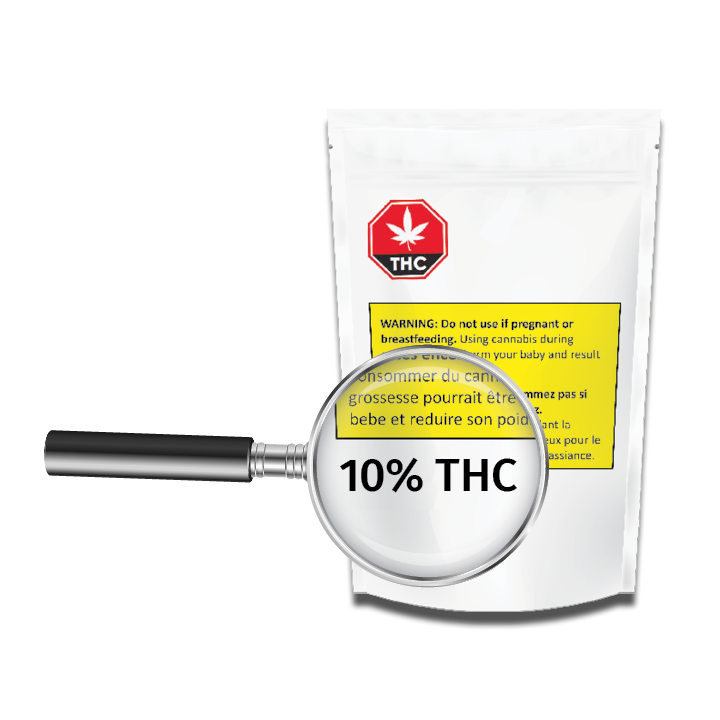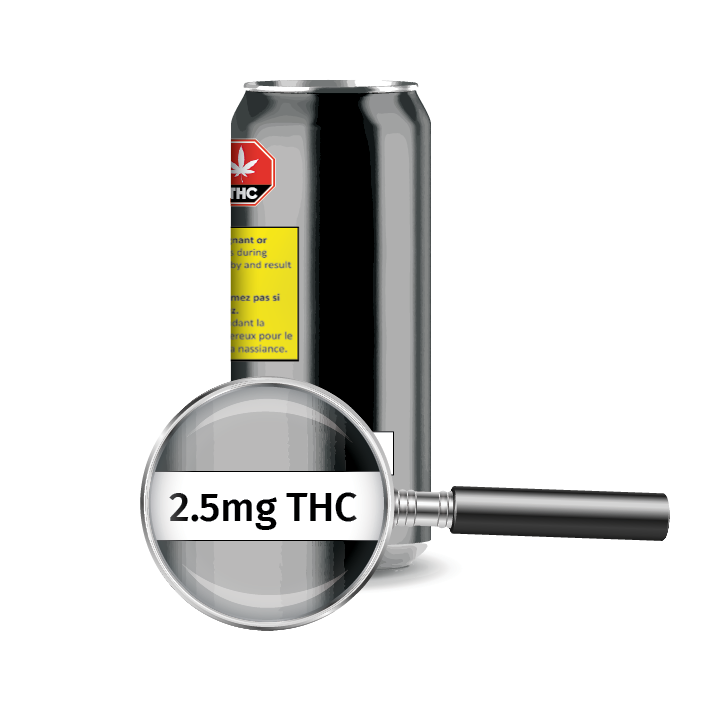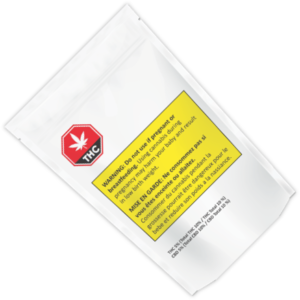Reading and understanding the label.
Learn what's in your cannabis.
While there are over 100 different chemicals in cannabis called cannabinoids, there are really only two that you need to know about.
One chemical is delta-9-Tetrahydrocannabinol (THC). THC is the main psychoactive ingredient in cannabis. It's what makes people feel high.
The amount of THC determines the strength or potency of a cannabis product. The amount of THC in a cannabis product depends on the variety of the cannabis plant, the way it was grown, the part of the plant that’s used, and the way the plant was prepared for use and stored.
The effects of cannabis vary based on its strength or potency. The more THC in the cannabis a person consumes, the more powerful the high. For a person who is new to cannabis, higher THC levels can lead to increased risks for negative effects (i.e., confusion, nausea or anxiety) or overdose. People who regularly consume cannabis with higher THC levels may be at greater risk for cannabis dependence.
Average levels of THC have been steadily increasing since the 1970s, because of changes in the way cannabis is grown. People who tried cannabis years ago need to be aware that it is stronger now.
THC interacts with your body -- mostly your brain, lungs, liver and kidneys – and interacts with the things that control pain, mood, and other feelings. That's why THC can make you feel good and gives you that so-called high.
The other chemical is cannabidiol (CBD). CBD doesn't cause a high. Instead, it's thought to provide feelings of relaxation and calmness. More CBD may also reduce risk, because CBD mitigates the effects of THC.
CBD is being studied extensively for its potential medical uses, but cannabis retail staff can’t give you medical advice. If you’re interested in using cannabis for medical or health purposes, you should talk to your doctor.
THC for dried cannabis is shown as a percentage. This tells you what the possible maximum amount of THC could be when you smoke or vape the cannabis. You’ll see percentages ranging from less than 1% up to approximately 30%. Products with less than 10% THC are considered less risky than those with higher percentages.
Dried cannabis is generally smoked or vaped, and the intoxicating effects are instant.
THC and CBD content in edibles and extracts are shown in milligrams (mg). These are products you eat, drink, vape or place under your tongue. You’ll see ranges of less than 1 mg up to 30 mg. Each package, including containers of beverages, will have a maximum of 10 mg of THC, but may contain more than one serving, for example, two chocolates or five candies Products containing less than 2.5 mg of THC are considered less risky than those containing higher mg. Higher THC content can increase your risk of adverse effects.
Typically, edibles can take up to two hours to kick in, full effects can peak within four hours, and effects can last up to 12 hours. However, manufacturers and food scientists are developing new ways to infuse cannabis into different foods and drinks, and to reduce the time it takes for someone to feel the effect. Ask cannabis retail staff how long it typically will take the product you are considering to take effect, and how long the effect may typically last.
THC for dried cannabis is shown as a percentage.
This tells you what the possible maximum amount of THC could be when you smoke or vape the cannabis. You’ll see percentages ranging from less than 1% up to approximately 30%. Products with less than 10% THC are considered less risky than those with higher percentages.
Dried cannabis is generally smoked or vaped, and the intoxicating effects are instant.

THC and CBD content in edibles and extracts are shown in milligrams (mg).

These are products you eat, drink, vape or place under your tongue. You’ll see ranges of less than 1 mg up to 30 mg. Each package, including containers of beverages, will have a maximum of 10 mg of THC, but may contain more than one serving, for example, two chocolates or five candies Products containing less than 2.5 mg of THC are considered less risky than those containing higher mg. Higher THC content can increase your risk of adverse effects.
Typically, edibles can take up to two hours to kick in, full effects can peak within four hours, and effects can last up to 12 hours. However, manufacturers and food scientists are developing new ways to infuse cannabis into different foods and drinks, and to reduce the time it takes for someone to feel the effect. Ask cannabis retail staff about how long it typically will take the product you are considering to take effect, and how long the effect may typically last.
Read the label.
The only way to know how much THC is in a product is to read the product’s label. Cannabis packages must identify the THC and CBD content. If you’re unsure about what is in a product or how to read the label, ask cannabis retail staff before you purchase your products. When in doubt, start with a small amount and wait to see how you feel before taking more.
With any intoxicating substance there is risk. While you technically can’t overdose from cannabis, too much THC can cause some really awful reactions. Click here to look at some of the health risks associated with using cannabis.


